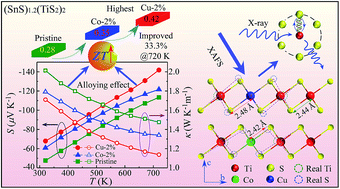Boosting the thermoelectric performance of misfit-layered (SnS)1.2(TiS2)2 by a Co- and Cu-substituted alloying effect†
Abstract
Understanding the alloying effect is of critical significance for rationally designing highly efficient thermoelectric materials. Here, we report that a Co- and Cu-substituted alloying effect in misfit-layered (SnS)1.2(TiS2)2 can directly enhance the thermoelectric performance with the highest dimensionless figure of merit ZT of ∼ 0.42 at 720 K until now. The substitution of Co3+ and Cu2+ for Ti4+ ions reduces the electron carrier concentration of the n-type material, thereby contributing to the increase of the Seebeck coefficient, which is clearly evidenced by the Hall measurement. In addition, the introduction of point defects due to the Co and Cu substitution gives rise to the decrease of phononic thermal conductivity. Consequently, the Co- and Cu-substituted alloying effect triggers an optimized carrier concentration, local mass fluctuation, and local strain variation, which inherently lead to the enhancement of thermoelectric properties owing to the combined effect of improved electrical transport properties and increased phonon scattering. The present misfit-layered chalcogenide provides an excellent platform for modulating the thermoelectric performance via an element-substituted alloying effect.



 Please wait while we load your content...
Please wait while we load your content...